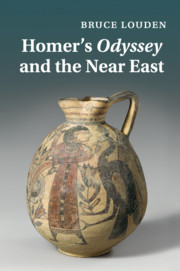Book contents
- Frontmatter
- Contents
- Acknowledgements
- Introduction
- 1 Divine councils and apocalyptic myth
- 2 Theoxeny
- 3 Romance
- 4 Odyssey 4
- 5 Odyssey 5
- 6 Odyssey 6–8, 10–12, 13.1–187; Genesis 28–33; Argonautic myth
- 7 Odysseus and Jonah
- 8 The combat myth
- 9 Catabasis, consultation, and the vision
- 10 Thrinakia and Exodus 32: Odysseus and Moses
- 11 The suitors and the depiction of impious men in wisdom literature
- 12 Odysseus and Jesus
- 13 Contained apocalypse
- Conclusion
- Bibliography
- Index locorum
- Subject index
12 - Odysseus and Jesus
The king returns, unrecognized and abused in his kingdom
Published online by Cambridge University Press: 04 February 2011
- Frontmatter
- Contents
- Acknowledgements
- Introduction
- 1 Divine councils and apocalyptic myth
- 2 Theoxeny
- 3 Romance
- 4 Odyssey 4
- 5 Odyssey 5
- 6 Odyssey 6–8, 10–12, 13.1–187; Genesis 28–33; Argonautic myth
- 7 Odysseus and Jonah
- 8 The combat myth
- 9 Catabasis, consultation, and the vision
- 10 Thrinakia and Exodus 32: Odysseus and Moses
- 11 The suitors and the depiction of impious men in wisdom literature
- 12 Odysseus and Jesus
- 13 Contained apocalypse
- Conclusion
- Bibliography
- Index locorum
- Subject index
Summary
As the hero who thematically triumphs over death, and can bring other mortals back from the underworld, Odysseus shares several traditional motifs with Christ as he is depicted in New Testament myth. Implicit in the episode of the Lotus Eaters, from which island Odysseus successfully brings all his men back alive, though against their will, Odysseus' ability to triumph over death is thematic throughout the Odyssey. The escape from Polyphêmos' cave, which suggests a miniature of the underworld, is perhaps the most emphatic instance. Odysseus saves all of his crew who entered the cave with him, except the six the Cyclops ate. On Aiaia, where half the crew had been turned into swine, he saves them by having Kirke restore their proper form. They would have otherwise been slaughtered, possibly eaten, if remaining in their porcine state, shut in pens to be fattened. Odysseus brings all his crew back from Hades (other than Elpenor, who had earlier gone by himself) after consulting Teiresias, a literal return from death. But the ability to triumph over death typifies most ancient heroes, and is thus a somewhat generic parallel between the Homeric Odysseus and Christ. The Odyssey depicts Odysseus' triumphs over death as heroic acts, fitting an epic modality, whereas NT myth depicts Christ's triumphs over death less as heroic acts, more as how a god, Dionysus, for instance, would accomplish such acts.
- Type
- Chapter
- Information
- Homer's Odyssey and the Near East , pp. 258 - 282Publisher: Cambridge University PressPrint publication year: 2011

